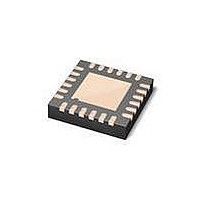MAX6581TG98+ Maxim Integrated Products, MAX6581TG98+ Datasheet - Page 20

MAX6581TG98+
Manufacturer Part Number
MAX6581TG98+
Description
Board Mount Temperature Sensors 1 C ACCUR 8-CH TEMP SENSR
Manufacturer
Maxim Integrated Products
Datasheet
1.MAX6581ATG9A.pdf
(24 pages)
Specifications of MAX6581TG98+
Full Temp Accuracy
+/- 1 C
Package / Case
TQFN-24
Digital Output - Bus Interface
I2C
Digital Output - Number Of Bits
11 bit
Supply Voltage (max)
3.6 V
Supply Voltage (min)
3 V
Description/function
Multichannel Temperature Sensor
Maximum Operating Temperature
+ 125 C
Minimum Operating Temperature
- 40 C
Supply Current
4 uA
Lead Free Status / RoHS Status
Lead free / RoHS Compliant
Table 12. Resistance Cancellation Register (4Ah)
±1°C Accurate 8-Channel Temperature Sensor
Some thermal diodes on high-power ICs have exces-
sive series resistance that can cause temperature-mea-
surement errors when used with conventional remote-
temperature sensors. Channels 1–7 of the MAX6581
have a series-resistance cancellation feature (enabled
by bits [7:0] of the Resistance Cancellation register) that
eliminates the effect of diode series resistance and inter-
connection resistance. Set these bits to 1 if the series
resistance is large enough to affect the accuracy of the
channels. The series-resistance cancellation function
increases the conversion time for the remote channels by
125ms (typ). This feature cancels the bulk resistance of
the sensor and any other resistance in series (e.g., wire,
contact resistance, etc.). The cancellation range is from
0I to 100I.
The MAX6581 directly measures the die temperature of CPUs
and other ICs that have on-chip temperature-sensing diodes
(see the Typical Application Circuit), or it can measure the
temperature of a discrete diode-connected transistor.
X = Don’t care.
20
7 (MSB)
BIT
6
5
4
3
2
1
0
_____________________________________________________________________________________
CANCELLATION 7
CANCELLATION 6
CANCELLATION 5
CANCELLATION 4
CANCELLATION 3
CANCELLATION 2
CANCELLATION 1
RESISTANCE
RESISTANCE
RESISTANCE
RESISTANCE
RESISTANCE
RESISTANCE
RESISTANCE
Applications Information
Series-Resistance Cancellation
NAME
X
Remote-Diode Selection
STATE
POR
0
0
0
0
0
0
0
0
—
Channel 7 Resistance Cancellation Enable Bit. Set this bit to logic 1 to enable
resistance cancellation. Set this bit to logic 0 to disable resistance cancellation.
Channel 6 Resistance Cancellation Enable Bit. Set this bit to logic 1 to enable
resistance cancellation. Set this bit to logic 0 to disable resistance cancellation.
Channel 5 Resistance Cancellation Enable Bit. Set this bit to logic 1 to enable
resistance cancellation. Set this bit to logic 0 to disable resistance cancellation.
Channel 4 Resistance Cancellation Enable Bit. Set this bit to logic 1 to enable
resistance cancellation. Set this bit to logic 0 to disable resistance cancellation.
Channel 3 Resistance Cancellation Enable Bit. Set this bit to logic 1 to enable
resistance cancellation. Set this bit to logic 0 to disable resistance cancellation.
Channel 2 Resistance Cancellation Enable Bit. Set this bit to logic 1 to enable
resistance cancellation. Set this bit to logic 0 to disable resistance cancellation.
Channel 1 Resistance Cancellation Enable Bit. Set this bit to logic 1 to enable
resistance cancellation. Set this bit to logic 0 to disable resistance cancellation.
When the remote-sensing diode is a discrete transistor,
its collector and base must be connected together. Table
13 lists examples of discrete transistors that are appro-
priate for use with the MAX6581. The transistor must be
a small-signal type with a relatively high forward voltage;
otherwise, the A/D input-voltage range can be violated.
The forward voltage at the highest expected temperature
must be greater than 0.25V at 10FA, and at the lowest
expected temperature the forward voltage must be less
than 0.95V at 100FA. Large power transistors must not
be used. Also, ensure that the base resistance is less
than 100I. Tight specifications for forward-current gain
(e.g., 50 < A < 150) indicate that the manufacturer has
good process controls and that the devices have con-
sistent V
transistors do not normally specify or guarantee ideality
factor. This normally is not a problem since good-quality
discrete transistors tend to have ideality factors that fall
within a relatively narrow range. Variations in remote
temperature readings of less than Q2NC with a variety of
discrete transistors have been observed. However, it is
good design practice to verify good consistency of tem-
perature readings with several discrete transistors from
any supplier under consideration.
BE
FUNCTION
characteristics. Manufacturers of discrete
Discrete Remote Diodes












